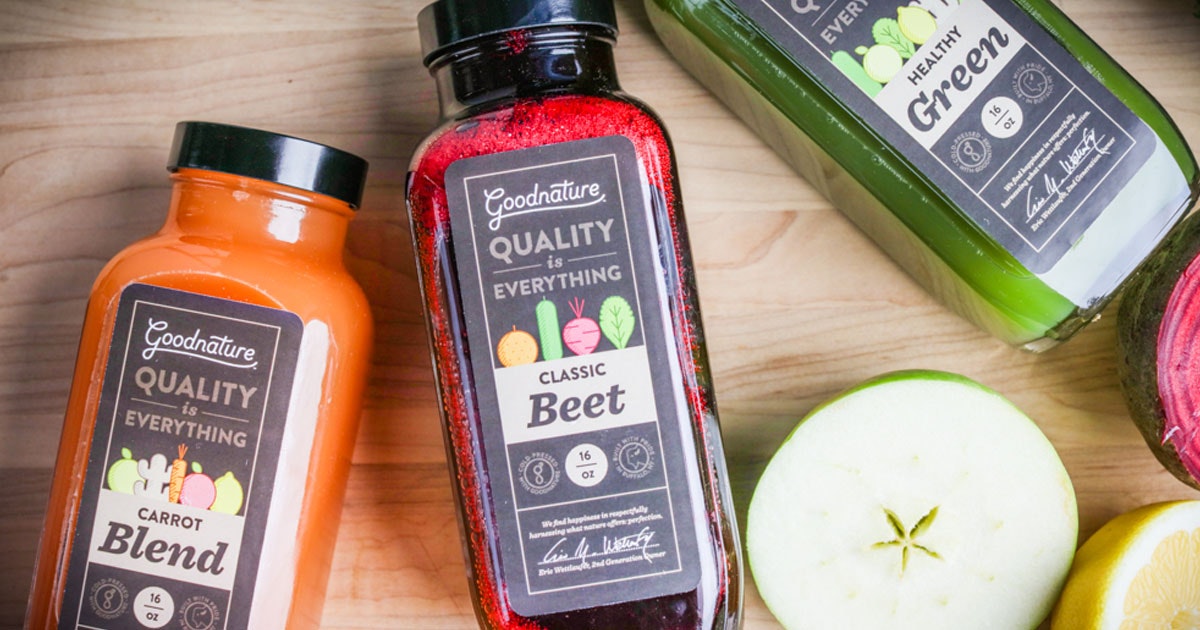For years the standard bottle of cold-pressed juice has been 16 or 17 ounces (often times “16 oz” bottles are actually 16.7), but lately you may have noticed a trend – the bottles are getting smaller, and coming in at around 12 oz / 350 ml. Let’s look at why…
Note: This How to Write a Juice Business Plan PDF is a step-by-step guide to helping you write a business plan for your juice business. Download it for free!

Why the standard was 16 ounces
When juicing was first gaining popularity around 2011, “cleansing” was the main focus. Celebrities were talking about it, people were blogging about it, and the results were amazing. People would report weight loss, higher energy, and in general felt great during and after a cleanse of 3 days or more. When cleansing, an entire day’s worth of food consists of five or six juices, making a bottle of juice essentially a meal replacement. So indeed, a full 16 ounces of juice is necessary in order to get enough calories and nutrients as a meal replacement.
Cleansing was a trend that peaked a couple of years ago. It’s still a thing, and many people still are doing regular juice cleanses with equally as positive results, but much of the juicing population has learned to work juicing into their daily routine in conjunction with solid foods. When drinking a bottle of juice along with regular 3-5 meals per day, it’s unnecessary to consume full 16 oz portions, assuming you are getting enough nutrients from your other food for a sustainable, healthy diet. Hence, there has been a gradual shift to smaller bottles of juice.
Now if you walk down the juice aisle at Whole Foods, you will notice that nearly all of the national brands have started adding smaller servings to their offerings, including Suja, Evolution Fresh, and Forager.
Advantages of smaller portions for a juice business
- Daily consumption – Encourages regular, multiple servings per day as opposed to being a meal replacement.
- Lower price point – Allows companies to lower the price of a bottle of juice, targeting a broader market.
- Higher profitability – A juice business may be able to obtain more profit per ounce at a smaller serving size.
- Higher hourly production – Clearly it’s easier to produce more bottles per hour when the bottles are smaller.
Offering multiple sizes
I’ve been thinking a lot about various juice sizes since I got into the industry, and I’ve formed the (humble) opinion that a standard offering should be 12 ounces, but a business can keep the 16 ounce sizes on the menu for juice cleanse packages. If you are currently offering 16 ounce servings, try also offering 12 ounce servings and see how your customers respond. Maybe they would prefer to save $1 or $2 per bottle and get a few ounces less of juice per serving. If they continue to purchase the more expensive 16 oz portions, then by all means, give your market what they want.
If you have any thoughts on this or you have done any experimenting, let our readers know by commenting below.

Comments
i'm juicing at home for me so would it be wise to get 12oz or 16 oz bottles...
Hi Dan, its really a personal preference, but if you want to follow our recipes, we use 12 oz. You can find our recipes here: https://www.goodnature.com/recipes
Why everybody says. that. the 12 oz juice is more profitable than the. 16 0z? and which formula can I use to convert my 16 oz juice recipe for a 12 oz recipe juice?
Thank you!
Hello, To convert your recipes from 16oz to 12oz, you can just multiply the weight of each ingredient by 0.75.
The juice bars in my area serve 16oz juices. Should I be the one who starts serving 12oz at a lower price point or stick with my competitors and go along with the market?
Hi Lindsay,
As a marketing manager, I would say this sounds like the perfect opportunity to help set yourself apart from the competition!
I see, so if it's 8 bottles of 12 oz that would work. All my juices will be pre packaged and I would like it to be readily available for them to pick and choose whenever. I will have a chart explaining the 3 different levels of cleanses and the starter juice options as well as finishing nut milks. Thank you
yes 8 bottles would work! I haven't seen cleanses sold this way but people might like the idea of having 8 servings instead of 6 while on a cleanse. Cleanses are a great way to bundle your recipes together. Let us know how it goes
Hi Charlie, I decided to go with the 12 oz. bottles. I want to offer cleanses though, how many bottles of 12oz. juice do you suggest a day for a 3 day cleanse?
Have you considered sticking with 16 oz for cleanses? I think the larger juice sizes are appropriate for cleanses since it's a meal replacement so you need a lot of juice!
Hi
What is the going rate for a 16ozs bottle of organic juice
It depends on where you are shopping, but usually around $6.99 - $9.99
hi guys, just a quick question. is it a glass bottle ? cheers
Hi!
We are currently making 3 and 5l juices, so some distance to cover before 350ml. We are concerned about the impact of the smaller packaging on the environment. Especially as our company is based in a country with limited formalised recycling. So we want to avoid plastics really. However, the roads are rough, so glass bottles are a worry also. The other thing is cost. The bag-in-a-box packaging machine was relatively affordable, but bottling lines seem super expensive. Where to start? Our customers are keen to get smaller sizes. We are in Tanzania. Warm regards!
Have you considered doing a recycling program? You can offer to give credit for your customers who return the bottles to you, so you can reuse them. There are many local juice companies that do this with glass bottles in the US. It is quite a difficult thing to manage, but if reducing waste is a priority for you, you can consider it.
I’ve enjoyed the smaller juice bottles. Adding it to my daily routine has become a habit. Easier to add a 5-7$ than a 9-12$ bottle.
Good article Charles 😄
Currently our best seller is 250ml (8.45oz) Irish strawberry and apple. pressed using traditional hydro press. We sell this juice for €3.00 per unit. We believe people only need one bottle per day and usually return weekly for our 7 for €20 offer. We are seriously considering one of goodnatures machines.
Sounds like a great recipe! Hydro presses are pretty neat. Do you know what yield you are getting? How much juice per kg of apple?
Hey Charlie! Love your post and thoughts! We've had the same experiences with our juices. We decided to opt for smaller juice sizes to save waste as our customers weren't consistently finishing their juice. Thanks for your insight!
Hi I and my eleven year old daughter have a dream of owning our own juice/vegan cafe business. Are there any tips you can give us ? I am coming into some money around the first of the year and might be able to make our dream a reality. Any tips towards making our business a success would be appreciated.
Toni, love to hear that you are looking to get into the business. I would say that reading through the blog here is a great first step, most of the common questions are answered somewhere on the blog.
We introduced 10 oz bottles to go along with our 16 oz bottles two years ago, and it has been a huge success because of the reasons you list above. The $5 price point (compared to $7) is attractive to many people, and more profitable for us! Plus many times customers are 'on the go' with no way to keep the juice cold, and 16 ounces is more than they want at one sitting. Ten ounces is perfect.
Great comment thanks for sharing!


Comment